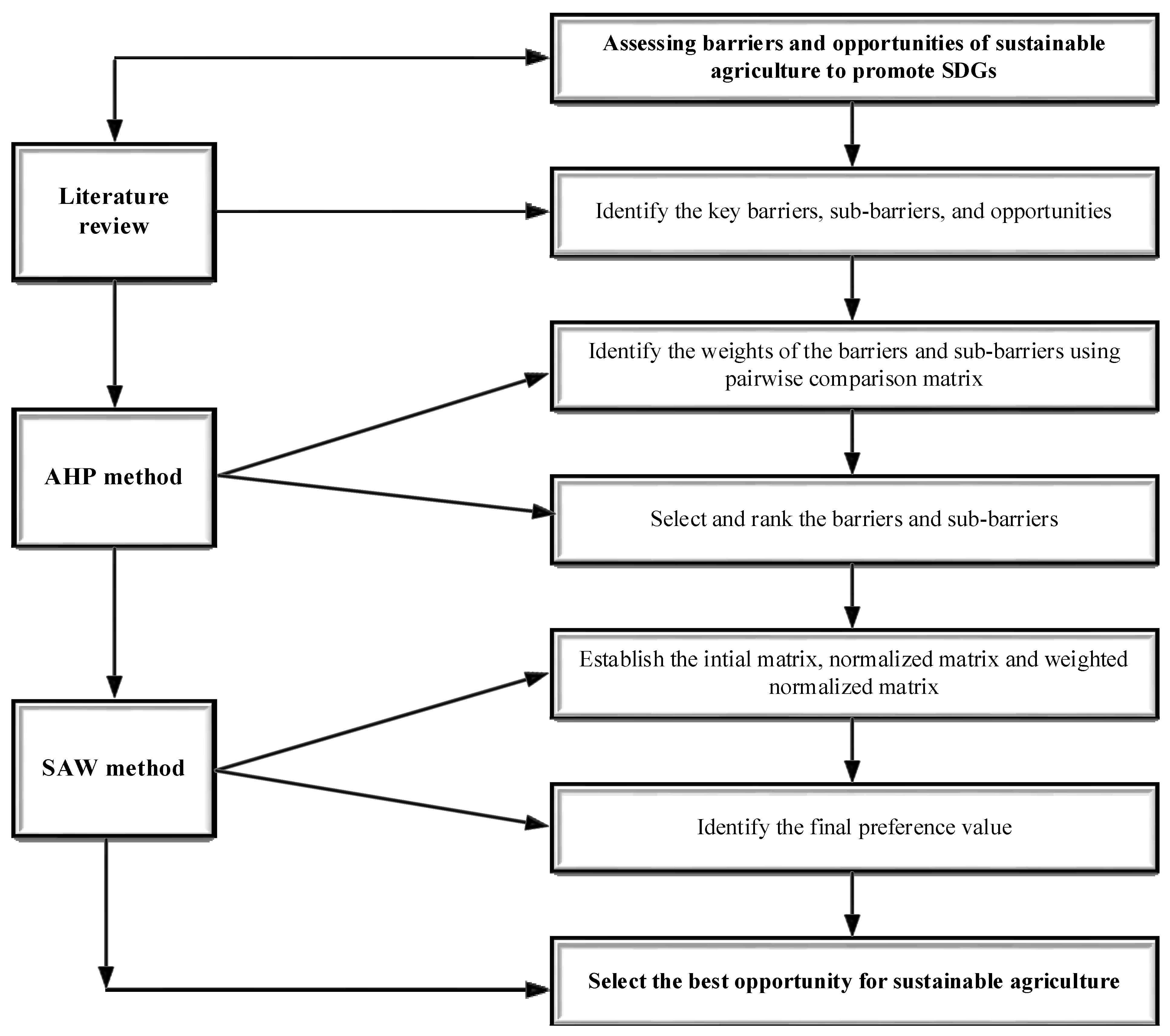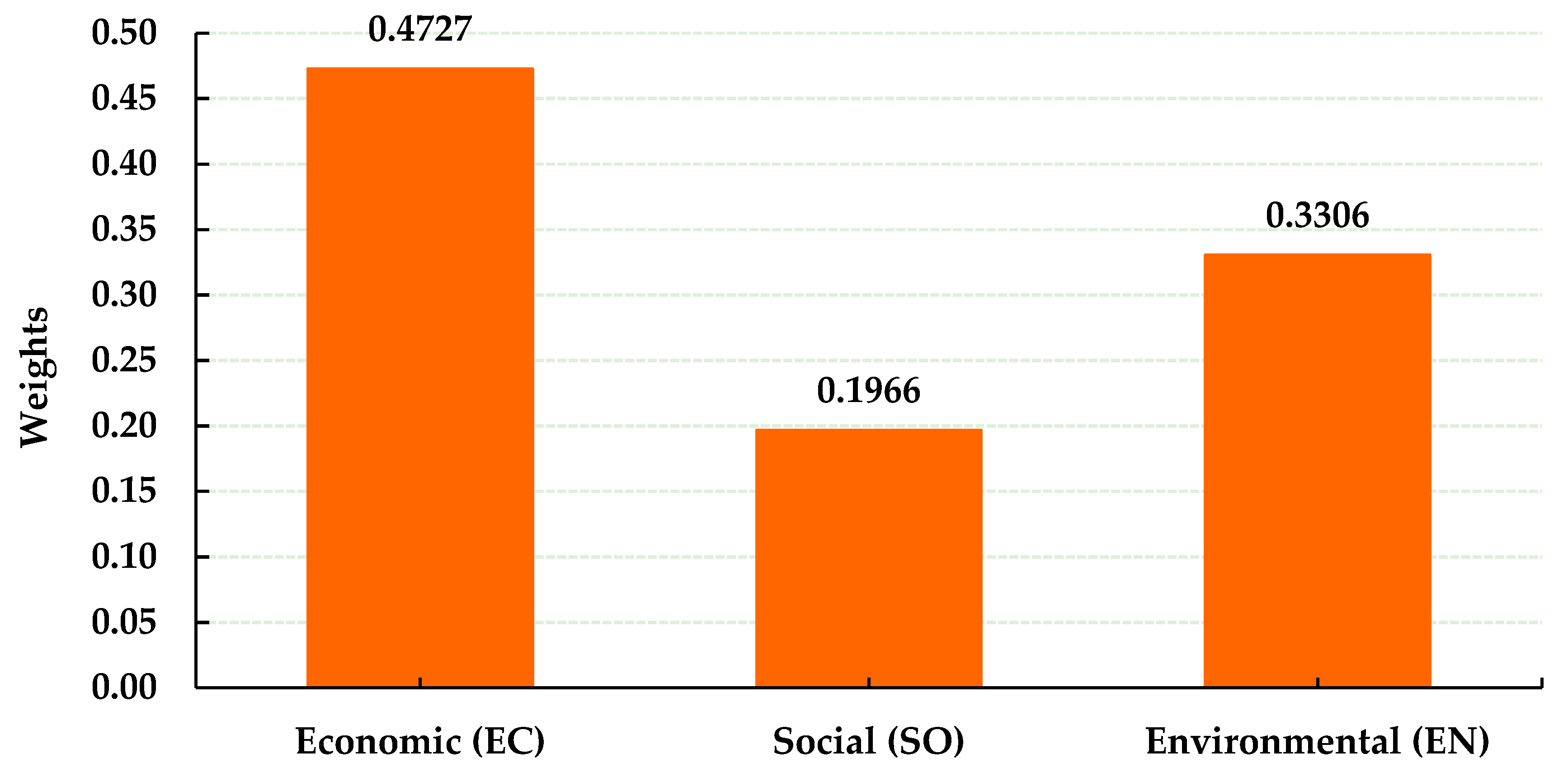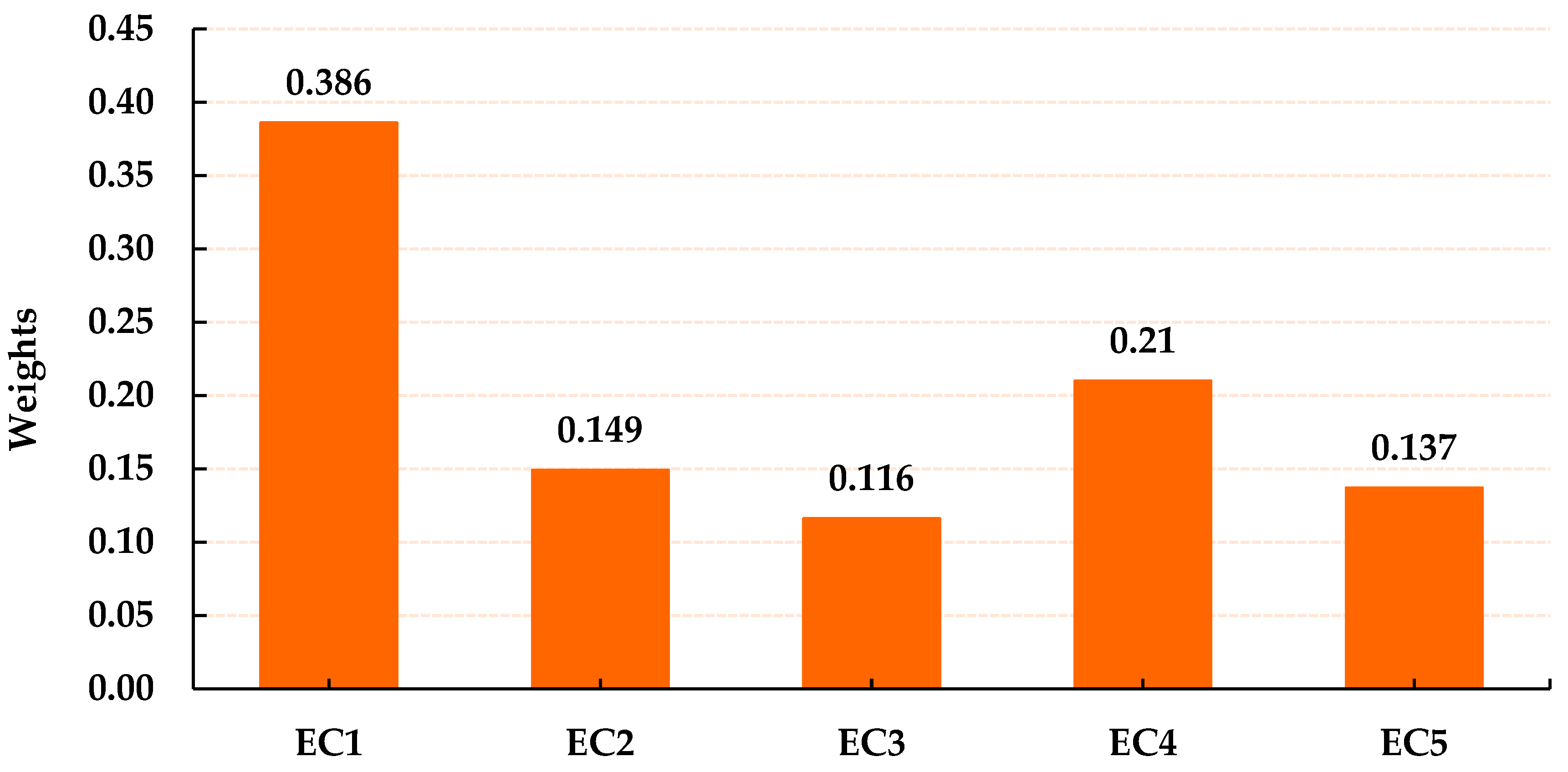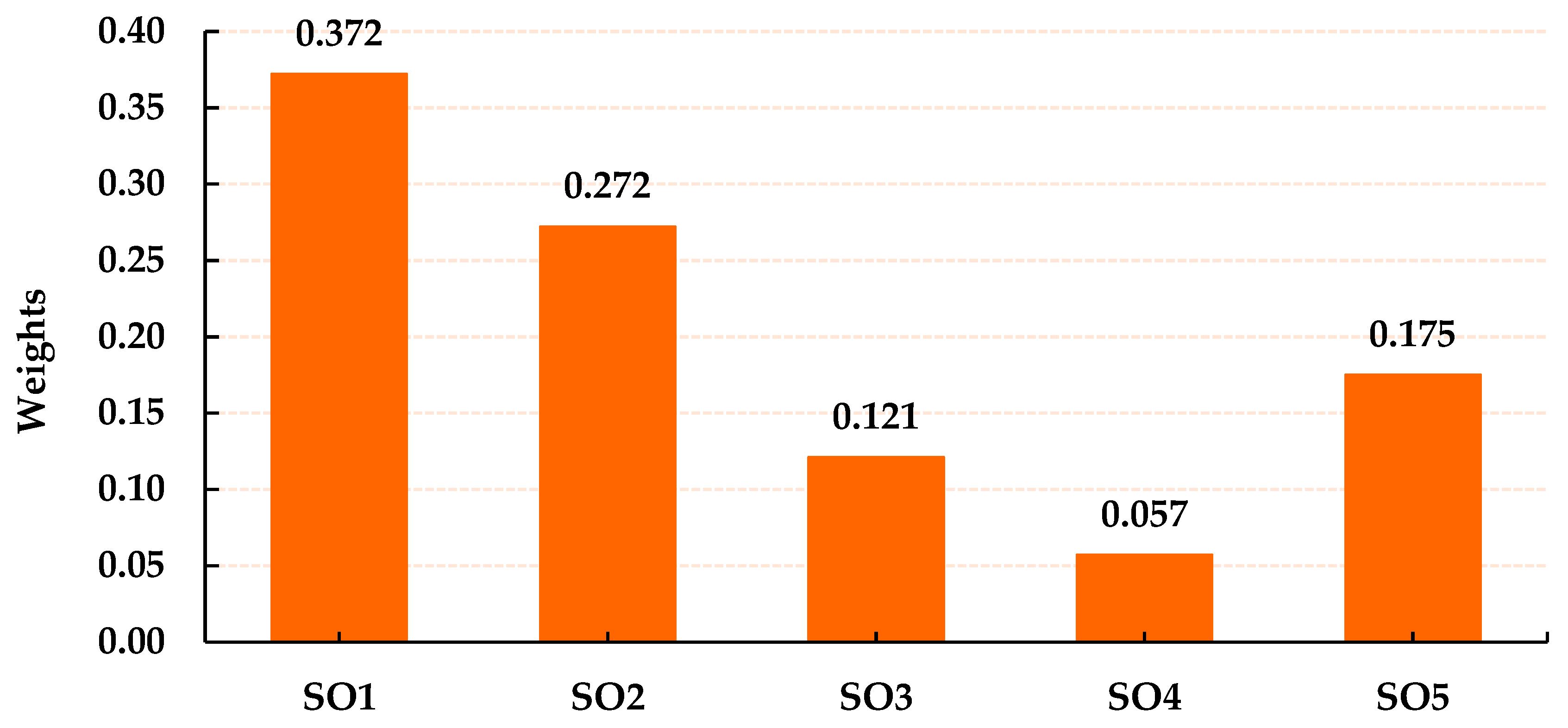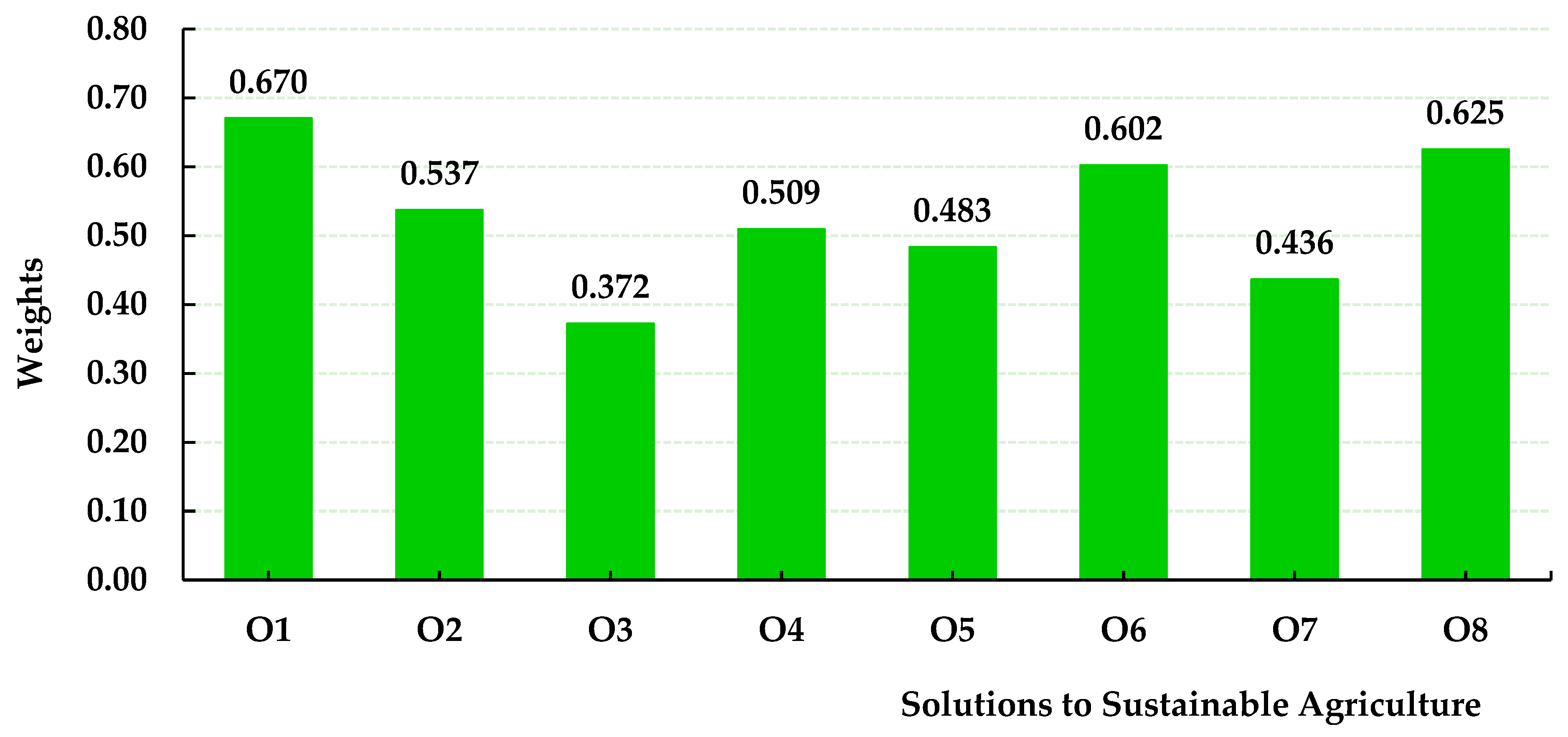1. Introduction
The United Nations has acknowledged sustainable agriculture as crucial to accomplishing the Sustainable Development Goals (SDGs) [
1]. The SDGs serve as a worldwide plea to end poverty, safeguard the planet, and guarantee peace and prosperity for all. Sustainable agriculture can play a role in accomplishing various SDGs, including SDG 1 (No Poverty), SDG 2 (Zero Hunger), SDG 6 (Clean Water and Sanitation), SDG 12 (Responsible Consumption and Production), and SDG 13 (Climate Action) [
2]. Sustainable agriculture entails a collection of principles and practices, including conservation agriculture, agroforestry, integrated pest management, and organic farming. These reduce agriculture’s environmental impact and promote economic and social sustainability [
3]. China’s rapid economic growth in recent decades has increased demand for agricultural products. This expansion has caused environmental degradation and social inequity, which are significant issues [
4]. China has turned to sustainable agriculture to promote social, economic, and environmental sustainability [
5]. This requires socially acceptable, commercially profitable, and environmentally sustainable farming [
6]. Sustainable agriculture in China means boosting productivity, distributing gains fairly, and safeguarding the environment. Due to the government’s focus on sustainable development and public awareness, the country’s sustainable agriculture has increased.
Several studies have highlighted the benefits of sustainable agriculture for achieving the SDGs [
7,
8,
9]. By increasing agricultural output and decreasing food loss and waste, for instance, sustainable agriculture has the potential to enhance food security. Through the provision of income and livelihood opportunities for smallholder farmers and the promotion of rural development, sustainable agriculture can also aid in the reduction of poverty. Additionally, sustainable agriculture can improve environmental sustainability by lowering greenhouse gas emissions, protecting natural resources, and fostering biodiversity [
10]. Sustainable agriculture may have advantages, but some obstacles prevent its widespread use. For smallholder farmers, one of the biggest obstacles is a lack of access to resources like land, water, and seeds [
11]. This obstacle is prevalent in developing nations, where smallholder farmers are frequently marginalized and need help accessing resources. The detrimental effects of agriculture on the environment, such as soil erosion [
12], water pollution, and biodiversity loss, provide another obstacle. Unsustainable agricultural practices [
13,
14], such as extensive monoculture and excessive use of pesticides and fertilizers, frequently lead to these harmful effects. The third obstacle is the slow uptake of sustainable agricultural practices, including integrated pest control, agroforestry, and conservation agriculture. Lack of information and awareness among farmers, as well as institutional and governmental barriers [
15,
16], frequently prevent the implementation of these practices. Finally, a significant obstacle to widespread adoption is the need for more institutional support and political will.
Sustainable agriculture and SDGs can be achieved in several ways. Sustainable agriculture could improve food security, poverty, and the environment [
17]. This demand is driven by concerns about the negative impacts of agriculture on the environment and public health, as well as a growing awareness of the importance of sustainable agriculture for achieving the SDGs. A third solution is the potential for sustainable agriculture to create jobs and stimulate economic growth. Sustainable agriculture can provide income and livelihood opportunities for farmers, as well as promote rural development and stimulate the growth of related industries, such as agro-processing and tourism [
18]. Moreover, the availability of new technologies and innovations, such as precision agriculture, biotechnology, and renewable energy, can enhance the sustainability of agriculture and provide new solutions for promoting the SDGs [
19].
Promoting sustainable development goals in China requires examining and ranking the challenges and solutions of sustainable agriculture. China, the world’s most significant agricultural producer, must adopt sustainable agricultural practices to preserve agricultural production, protect natural resources, and advance food security. Several obstacles, including a need for more suitable legislative backing, funding, and technical innovation, nonetheless hamper the implementation of sustainable farming practices. There is a dire need to formulate efficient strategies for promoting sustainable agriculture by analyzing and prioritizing these obstacles, such as enhancing policy frameworks, boosting investment in sustainable agriculture, and encouraging technological innovation. It would help China accomplish its targets for sustainable development, including eradicating poverty and hunger, fostering environmentally friendly consumption and production, and safeguarding human health. In the end, preserving the long-term sustainability of China’s agriculture industry and attaining sustainable development goals depend on analyzing and prioritizing the challenges and solutions of sustainable agriculture.
The contribution of this research paper is twofold. First, it provides a comprehensive assessment of the barriers and solutions of sustainable agriculture for promoting SDGs, which can help decision-makers identify the key challenges and solutions and develop effective strategies for promoting sustainable agriculture and achieving SDGs. Second, it demonstrates the application of Multi-Criteria Decision Making (MCDM) methods, specifically Analytical Hierarchy Process (AHP) and Simple Additive Weighting (SAW), in evaluating and ranking the barriers and solution options and identifying the most suitable options for promoting sustainable agriculture and achieving SDGs in China.
The research paper is organized as follows. In the next section (
Section 2), we provide a literature review, identify barriers, sub-barriers, and solution strategies. In
Section 3, we describe the methodology used in this research. In
Section 4, we present the results, discussions, and implications of research. Finally, in
Section 5, we discuss the conclusion and provide recommendations for promoting sustainable agriculture and achieving the SDGs.
3. Methodology
To attempt to evaluate the challenges and potential solutions of sustainable agriculture for advancing SDGs in the context of China, this study used the MCDM approach. With uncertain or hazy information, the MCDM approach enables the consideration of multiple criteria, sub-criteria, and alternatives. This study conducted a thorough literature analysis to pinpoint the main barriers, sub-barriers, and solution strategies for the development of sustainable agriculture. Firstly, the study uses the AHP [
79] to assess and rank the importance of barriers and sub-barriers to sustainable agriculture for promoting SDGs. Secondly, the research uses the SAW method [
80] to analyze and rank the solutions based on their overall performance for sustainable agriculture development.
Figure 1 presents the decision model of the study. Two multi-criteria decision-making techniques that may be used to evaluate obstacles, sub-barriers, and alternatives for sustainable agriculture are AHP and SAW (Simple Additive Weighting). AHP is a systematic method that assists decision-makers in prioritizing and weighing various criteria or options according to their relative weight. Decision-makers may then compare the simpler, easier-to-manage components of complicated challenges on a single scale. AHP helps determine the relative significance of obstacles, sub-obstacles, and sustainable agricultural options based on various environmental, economic, and social variables [
79,
81,
82].
SAW is another multi-criteria decision-making technique that may be used to evaluate obstacles, sub-obstacles, and sustainable agricultural options. In SAW, many criteria and options are given weights according to their importance, and the weights are then added together to provide an overall score [
80]. SAW helps evaluate sustainable agricultural hurdles, sub-barriers, and options based on various factors, including affordability, viability, and sustainability. Decision-makers may identify the most critical strategies, sub-strategies, and impediments to sustainable agriculture by systematically evaluating and prioritizing them based on various criteria using AHP and SAW. These techniques offer a clear and organized process for making decisions, which can guarantee that choices are founded on solid logic and are made objectively. Additionally, by including stakeholders in the decision-making process and considering their suggestions and preferences, AHP and SAW can promote stakeholder engagement and consensus-building. Overall, using AHP and SAW can increase decision-making effectiveness and efficiency concerning sustainable agriculture.
3.1. AHP Method
Saaty developed the AHP method in the 1970s [
79]. The AHP is a MCDM method that involves breaking down complex decisions into smaller, more manageable parts [
83,
84]. This method enables decision-makers to prioritize and rank criteria and sub-criteria based on the problem.
The AHP method involves the following steps [
82]:
The first step involves identifying the criteria and sub-criteria that are relevant to sustainable agriculture and the promotion of the SDGs.
The highest level of the hierarchy is the goal, which is to promote sustainable agriculture and achieve the SDGs. The next level is the criteria, which represent the economic, social, and environmental aspects of sustainable agriculture. The lowest level is the sub-criteria, which are the specific factors that contribute to each criterion.
Step 3. Development of a pair-wise comparison matrix of the decision-problem using Saaty’s 1–9-point scale.
Table 4 presents Saaty’s 1–9 points scale.
In this step,
CI can be used to measure the consistency of the pair-wise comparison of the matrix.
CI can be presented as [
81].
here
is the eigenvalue and
is the no. of main criteria
where
RI is the random consistency index, which is presented in
Table 5. During the pair-wise comparison, the consistency ratio (
CR) must be within the limit of 0.1; if it exceeds above 0.1, then the results could be inconsistent [
85].
The AHP is widely used in sustainable agriculture research to prioritize and rank criteria and sub-criteria based on the decision goal of the study. It is a flexible and transparent method that allows decision-makers to incorporate their preferences and judgments into the decision-making process.
3.2. SAW Method
The SAW is an MCDM method used to evaluate alternatives [
80]. In SAW, each choice is weighted for each criterion and ranked by their weighted aggregate score. SAW provides an instant evaluation of the alternatives depending on the chosen criteria [
86].
The SAW technique requires these steps [
80]:
Step 1. Construct the decision matrix:
where
aij is the value of alternative
i with respect to decision criterion
j.
Step 2. Normalize the decision matrix by the following equations:
Step 3. Determine the weights of decision criteria by subjective or objective weighting methods. The resulting weight vector would be as follows:
where
n is the number of decision criteria or evidence maps.
Step 4. Calculate the significance degree of each alternative by the following equation:
3.3. Experts of the Study
This study surveyed five specialists in sustainable agricultural fields such agronomy, environmental science, economics, and social sciences. Based on their publishing record, academic credentials, and expertise, the experts were chosen to assure the study’s quality and dependability. To ensure a varied variety of perspectives in the study, experts were picked from different locations and institutions. Webmail was used to consult specialists. The experts were involved in several stages of the study, including developing the criteria and sub-criteria for evaluating the barriers and solutions of sustainable agriculture for promoting SDGs, assigning weights to the criteria, and evaluating the alternative options using the AHP and SAW methods. The experts were involved in reviewing and validating the results of the study. The involvement of experts in the study can ensure that the results are based on sound scientific principles and reflect the current state of knowledge in the field of sustainable agriculture in China.
4. Results and Case Analysis
In this study, the case of China has been taken to determine the barriers and sub-barriers, that impede the development of sustainable agriculture and the SDGs. In this regard, the solution strategies proposed in the study to overcome the identified barriers and sub-barriers to promote sustainable agriculture development in the context of China.
4.1. Results of Main Barriers Using AHP
The AHP method was used to determine the weights of the main barriers to sustainable agriculture for promoting SDGs in China. The results of the pairwise comparisons among the main barriers are presented in
Table 6, along with the corresponding weights obtained using the AHP method. The final ranking is presented in
Figure 2.
According to the results, economic (EC) barriers were the most significant, with a weight of 0.4727. Environmental barriers came next, with a weight of 0.3306, and social barriers, with a weight of 0.1966. These results indicate that EC factors are the most important barriers to sustainable agriculture for promoting the SDGs, followed by EN and SO factors. Sustainable agriculture should target environmental barriers such soil erosion, water pollution, and land degradation to support SDGs, according to the research. Addressing economic challenges like inadequate financial resources and market access and social barriers like poor education and gender inequality could assist promote sustainable agriculture and achieve the SDGs [
55].
4.2. Results of Economic Sub-Barriers Using AHP
For promoting SDGs in China, the AHP technique was utilized to weight economic sub-barriers to sustainable agriculture.
Table 7 shows the pairwise sub-barrier comparisons and AHP weights.
Figure 3 ranks economic sub-barriers. According to the results, lack of financial incentives (EC1) was the most significant sub-barrier of economic barriers, with a weight of 0.386. This was followed by lack of government support (EC4), with a weight of 0.210, and limited access to credit (EC2), with a weight of 0.149. The short-term economic focus (EC5) and market barriers (EC3) ranked least important sub-barriers. These results indicate that addressing the sub-barriers of EC1 and EC4 could significantly contribute to promoting sustainable agriculture and achieving the SDGs. Improving financial incentives and government support can help farmers increase their productivity and income, which in turn can lead to the adoption of sustainable agriculture practices. Access to credit also needs to be addressed to make sustainable agriculture practices more accessible and affordable for farmers.
4.3. Results of Social Sub-Barriers Using AHP
The AHP method was also used to determine the weights of the sub-barriers of social barriers to sustainable agriculture for promoting SDGs in China. The results of the pairwise comparisons among the sub-barriers are presented in
Table 8, along with the corresponding weights obtained using the AHP method.
Figure 4 illustrates the ranking of social (SO) sub-barriers. According to the results, lack of awareness and education (SO1) was the most significant sub-barrier of social barriers, with a weight of 0.372. This was followed by cultural barriers (SO2), with a weight of 0.272, and gender inequalities (SO5), with a weight of 0.175. These results indicate that addressing the sub-barrier of SO1 is crucial for promoting sustainable agriculture and achieving the SDGs. Lack of education and awareness also need to be addressed to promote sustainable agriculture practices among farmers. Besides, providing equal opportunities for men and women in agriculture can lead to better economic, social, and environmental outcomes. The findings of this research are also supported by the findings in [
31], in which the authors concluded that “technical knowledge and a qualified workforce” were the most influential factors in adopting sustainable agriculture. According to Rodriguez et al. [
14], in addition to lack of funding, social barriers, land tenure, infrastructure and incompatibility are also important barriers to the adoption of sustainable agriculture practices.
4.4. Results of Environmental Sub-Barriers Using AHP
The AHP method was also used to determine the weights of the sub-barriers of environmental barriers to sustainable agriculture for promoting SDGs in China. The results of the pairwise comparisons among the sub-barriers are presented in
Table 9, along with the corresponding weights obtained using the AHP method.
Figure 5 presents the ranking of environmental (EN) sub-barriers. According to the results, climate change (EN4) was the most significant sub-barrier of EN barriers, with a weight of 0.310. Following this were energy use and emissions (EN5), with a weight of 0.199, and land degradation and soil erosion (EN1), with a weight of 0.306. These results suggest that addressing the sub-barrier of EN4 is crucial for promoting sustainable agriculture and achieving the SDGs. Climate change is a pressing issue that requires immediate action, such as the implementation of climate-smart agriculture practices. EN1 is another significant sub-barrier that needs to be addressed through the adoption of sustainable soil management practices, such as conservation tillage and cover cropping. This finding is supported by [
31] that environmental dimension variables such as climate change/soil control/production management affect the sustainability of agriculture.
4.5. Results of Overall Sub-Barriers Using AHP
Based on the AHP analysis, the overall sub-barriers of sustainable agriculture for promoting SDGs have been ranked.
Table 10 provides the overall sub-barrier ranking. The results indicate that the lack of financial incentives (EC1) and climate change (EN4) is the most significant sub-barrier, followed by land degradation and soil erosion (EN1) about sustainable agriculture practices. The findings suggest that addressing these sub-barriers is critical for promoting sustainable agriculture and achieving the SDGs in the context of China. In previous studies, lack of financial incentives has also been concluded to be one of the major barriers to sustainable agriculture [
7,
14,
45].
4.6. Results of Solutions Using SAW Method
The SAW method was used to evaluate the solutions of sustainable agriculture for promoting SDGs in China.
Figure 6 indicates the final ranking of solutions (alternatives) based on the decision goal of the study. The results suggest that encouraging the adoption of sustainable agriculture practices, such as investment in sustainable agriculture (O1), is the most significant solution for promoting sustainable agriculture and achieving SDGs. International cooperation (O8) alternative farming practices (O6) are also important solutions for promoting SDGs. Education and awareness (O2) and public-private partnerships (O4) are moderately important solutions for sustainable agriculture development. These two factors are more important than the arrangement presented in this study, because they are the basis for finding good (successful) agriculture practices that lead to sustainable agricultural development, and then transferring this knowledge to farmers to apply and benefit from it. Additionally, promoting sustainable supply chain management (O5), research and development (O7), and sustainable agriculture policies and regulations (O3), can strengthen the capacity of farmers and stakeholders in sustainable agriculture practices and innovation can further contribute to achieving the SDGs. The government should invest to promote sustainable agriculture practices [
14].
4.7. Discussion
The present study aimed to assess the barriers and solutions of sustainable agriculture for promoting SDGs using the AHP and SAW methods. The study identified and prioritized the main and sub-barriers in the economic, social, and environmental aspects of sustainable agriculture, and explored solutions for overcoming these barriers. The results of the study identified the main barriers to sustainable agriculture for promoting SDGs, as well as the sub-barriers in the economic, social, and environmental aspects. The main barriers identified by the study were limited financial resources, a lack of access to credit and market, and inadequate policies and regulations. These findings support the view of studies that financial and policy barriers hampered sustainable agricultural approaches [
4,
11].
Lack of financial incentives, government assistance, and credit were the economic barriers to sustainable agriculture. Lack of credit and market access inhibits sustainable agriculture and lowers farmer income [
46]. Lack of awareness and education, cultural obstacles and gender disparities were all social challenges to sustainable agriculture. The findings of this study are consistent with previous studies that have identified limited awareness, education, and social networks as significant barriers to the adoption of sustainable agriculture practices [
52,
67]. The sub-barriers identified in the environmental aspect of sustainable agriculture were climate change, land degradation and soil erosion, and energy use and emissions. These sub-barriers have been identified in previous studies as significant challenges to sustainable agriculture and food security [
19,
87]. The study also determined solutions for overcoming the barriers to sustainable agriculture and promoting the SDGs. The results of the SAW method identified that the application of sustainable agriculture practices such as investment in sustainable agriculture, International cooperation, and alternative farming practices, can provide solutions for achieving economic, social, and environmental sustainability. The findings of this study are consistent with previous studies that have highlighted the importance of sustainable agriculture practices in achieving economic, social, and environmental sustainability [
24,
41].
In one of the previous research used AHP method [
24], and identified that environmental and agricultural land availability are the strengths, while financial services and climate change are the weaknesses for sustainable agriculture development. Moreover, in another study, the authors proposed sustainable agriculture collaboration models using AHP to determine agricultural sustainability standards. The study indicated that private and cooperative partnership strategies are best for agricultural sustainability in Iran [
29]. There are also various barriers that obstruct the development of sustainable agriculture from a social, economic, and environmental perspective. For instance, the study showed that technical know-how and qualified workers are the major barriers to implementing sustainable agriculture practices [
31]. The results are in line with the current study’s findings, which also revealed that economic, environmental and social factors are the key drivers for sustainable agriculture development. In similar study, authors used the AHP method to assess agriculture sustainability from a regional perspective and selected the economic viability, environmental friendliness, and social criteria from sustainable pathways [
32]. Furthermore, sustainable priorities were suggested for the long-term vision of Poland’s agriculture industry. The authors used AHP method and identified that adaptation to climate change is most crucial factor, although limited financing options hinder the development of sustainable agriculture [
35]. Finally, the earlier study’s results also consistent with current study; they also indicated that the economic aspect is the most vital for farmers to concentrate on the sustainable economic performance component of their farms [
36].
The present study provides insights into the barriers and solutions of sustainable agriculture for promoting SDGs in the context of China. The findings of the study have implications for policymakers, researchers, and farmers who seek to promote sustainable agriculture practices and achieve SDGs in the country.
4.8. Policy Recommendations
Based on the findings of this study, the following policy recommendations are proposed:
Policies should prioritize creating awareness and training stakeholders to promote sustainable agriculture practices and help achieve the SDGs. This may be accomplished by providing farmers with training programs, extension services, and public awareness campaigns. Education and awareness policies assist stakeholders in comprehending the benefits of sustainable agriculture practices, encouraging their adoption, and promoting sustainable development.
The government should strengthen its support for sustainable agriculture practices and eliminate economic hurdles by providing money, subsidies, and other incentives. Such policies can encourage farmers to adopt sustainable practices while also assisting in resolving the economic difficulties mentioned in this study. The government may help the transition to sustainable agriculture and promote sustainable development by providing financial assistance.
Collaborations among many stakeholders, including farmers, NGOs, and government agencies, must be strengthened to promote sustainable agriculture and achieve the SDGs. Policies should prioritize the development of discourse and knowledge-sharing platforms, with an emphasis on developing partnerships. This can enhance stakeholder collaboration, the exchange of ideas and best practices, and the adoption of sustainable agriculture practices.
Policies should prioritize research and development efforts to address the constraints highlighted in this study and promote sustainable agriculture. This can aid in discovering novel and creative sustainable agriculture practices and solutions. Policymakers may encourage the adoption of sustainable agriculture practices, boost agricultural production, and advance sustainable development by investing in research and development.
Policies should encourage customers to adopt sustainable consumption patterns, such as decreasing food waste, purchasing locally farmed vegetables, and eating less meat. Such policies can lessen the demand for unsustainable agricultural practices while promoting sustainable agriculture. Policymakers can assist consumers in making educated decisions that contribute to sustainable development and encourage the implementation of sustainable agriculture practices by supporting sustainable consumption patterns.
Policies should prioritize the enhancement of monitoring and evaluation of sustainable agriculture practices in order to measure progress toward the SDGs and identify areas for improvement. It would assist policymakers in evaluating the efficacy of their policies and programs, identifying obstacles and opportunities, and making data-driven choices. Policymakers may guarantee that they are on track to meet their sustainable development goals and support adopting sustainable agricultural practices by monitoring and assessing sustainable agriculture practices.
In summary, supporting sustainable agricultural practices is essential for combating global issues, including poverty, food insecurity, climate change, and achieving the SDGs. Policies that prioritize education and awareness, government funding, collaborations, research and development, sustainable consumption, and monitoring and evaluation are crucial for overcoming obstacles and realizing the solutions to sustainable agriculture. Policymakers may promote sustainable agriculture practices, assist in sustainable development, and solve global concerns by enacting such legislation.
5. Conclusions
In order to investigate the main obstacles, auxiliary obstacles, and potential remedies of sustainable agriculture for advancing SDGs in China, the study adopted an MCDM methodology. The results of the analysis show that the most significant barriers to adopting sustainable agricultural practices in China have been rated, with economic considerations first followed by environmental and social barriers. The economic sub-factors show that the lack of financial incentives is the most critical factor impacting sustainable agriculture in China, with government support coming in at a close second. The Chinese government promotes sustainable agricultural practices, but specific issues must be resolved. Cultural barriers are the next most significant sub-factor needing particular care regarding social aspects, followed by a lack of knowledge and education. Climate change, land degradation, and soil erosion provide the biggest problems for the agriculture industry in terms of environmental sub-barriers. The most significant barriers to adopting sustainable farming practices are a need for more financial incentives, climate change, land degradation, and soil erosion. According to the ranking of strategies, investing in sustainable agriculture is the best way to accomplish sustainable agricultural goals in China.
The results showed that economic, social, and environmental reasons were the main barriers to attaining sustainable agriculture and advancing the SDGs. The report also highlighted several alternatives for addressing these issues and advancing sustainable agriculture, including using sustainable land use practices, adopting organic farming methods, and exploiting renewable energy sources. By implementing these solutions, we can promote environmental sustainability, social fairness, and economic growth—all of which are essential for achieving the SDGs. The study is remarkable in that it detailed sub-obstacles under each component, suggested techniques for overcoming them, and identified the main barriers and remedies. The use of MCDM approaches, particularly AHP and SAW, allowed for a thorough analysis of the problems and solutions related to sustainable agriculture and provided decision-makers with a framework for setting priorities.
This research is a valuable contribution to the literature on sustainable agriculture since it outlines the major and minor challenges to achieving the SDGs through sustainable farming practices. The study’s conclusions can help stakeholders in the agriculture sector make policy decisions about the challenges and opportunities for developing sustainable farming practices. Policymakers may create efficient policies and strategies for advancing sustainable agriculture practices and achieving the SDGs by addressing the acknowledged constraints and seizing the possibilities.
This study has limitations that should be considered when evaluating the findings. First, the study’s expert sample may only partially reflect the field’s expert population on sustainable agriculture because it was small. Future studies should include a more extensive and varied sample of experts to guarantee the generalizability of the findings. Second, because the study was limited to a single location and concentrated on the challenges and opportunities of sustainable agriculture in advancing the SDGs, its findings might need to be generalizable to other areas with varied environmental, economic, and social factors. Therefore, to identify region-specific policies and strategies, future research should examine the challenges and solutions of sustainable agriculture in various regions. Last but not least, this study used AHP and SAW techniques to assess the challenges and advancements of sustainable agriculture for the SDGs. However, different perspectives on the ranking of obstacles and solutions may be provided by other techniques like VIKOR, TOPSIS, DEMATEL, and ANP. The use of various techniques to validate the results of this study should thus be explored in further research.
